Syeda Nahida Akter
NVIDIA Nemotron 3: Efficient and Open Intelligence
Dec 24, 2025Abstract:We introduce the Nemotron 3 family of models - Nano, Super, and Ultra. These models deliver strong agentic, reasoning, and conversational capabilities. The Nemotron 3 family uses a Mixture-of-Experts hybrid Mamba-Transformer architecture to provide best-in-class throughput and context lengths of up to 1M tokens. Super and Ultra models are trained with NVFP4 and incorporate LatentMoE, a novel approach that improves model quality. The two larger models also include MTP layers for faster text generation. All Nemotron 3 models are post-trained using multi-environment reinforcement learning enabling reasoning, multi-step tool use, and support granular reasoning budget control. Nano, the smallest model, outperforms comparable models in accuracy while remaining extremely cost-efficient for inference. Super is optimized for collaborative agents and high-volume workloads such as IT ticket automation. Ultra, the largest model, provides state-of-the-art accuracy and reasoning performance. Nano is released together with its technical report and this white paper, while Super and Ultra will follow in the coming months. We will openly release the model weights, pre- and post-training software, recipes, and all data for which we hold redistribution rights.
Nemotron 3 Nano: Open, Efficient Mixture-of-Experts Hybrid Mamba-Transformer Model for Agentic Reasoning
Dec 23, 2025Abstract:We present Nemotron 3 Nano 30B-A3B, a Mixture-of-Experts hybrid Mamba-Transformer language model. Nemotron 3 Nano was pretrained on 25 trillion text tokens, including more than 3 trillion new unique tokens over Nemotron 2, followed by supervised fine tuning and large-scale RL on diverse environments. Nemotron 3 Nano achieves better accuracy than our previous generation Nemotron 2 Nano while activating less than half of the parameters per forward pass. It achieves up to 3.3x higher inference throughput than similarly-sized open models like GPT-OSS-20B and Qwen3-30B-A3B-Thinking-2507, while also being more accurate on popular benchmarks. Nemotron 3 Nano demonstrates enhanced agentic, reasoning, and chat abilities and supports context lengths up to 1M tokens. We release both our pretrained Nemotron 3 Nano 30B-A3B Base and post-trained Nemotron 3 Nano 30B-A3B checkpoints on Hugging Face.
NVIDIA Nemotron Nano 2: An Accurate and Efficient Hybrid Mamba-Transformer Reasoning Model
Aug 21, 2025



Abstract:We introduce Nemotron-Nano-9B-v2, a hybrid Mamba-Transformer language model designed to increase throughput for reasoning workloads while achieving state-of-the-art accuracy compared to similarly-sized models. Nemotron-Nano-9B-v2 builds on the Nemotron-H architecture, in which the majority of the self-attention layers in the common Transformer architecture are replaced with Mamba-2 layers, to achieve improved inference speed when generating the long thinking traces needed for reasoning. We create Nemotron-Nano-9B-v2 by first pre-training a 12-billion-parameter model (Nemotron-Nano-12B-v2-Base) on 20 trillion tokens using an FP8 training recipe. After aligning Nemotron-Nano-12B-v2-Base, we employ the Minitron strategy to compress and distill the model with the goal of enabling inference on up to 128k tokens on a single NVIDIA A10G GPU (22GiB of memory, bfloat16 precision). Compared to existing similarly-sized models (e.g., Qwen3-8B), we show that Nemotron-Nano-9B-v2 achieves on-par or better accuracy on reasoning benchmarks while achieving up to 6x higher inference throughput in reasoning settings like 8k input and 16k output tokens. We are releasing Nemotron-Nano-9B-v2, Nemotron-Nano12B-v2-Base, and Nemotron-Nano-9B-v2-Base checkpoints along with the majority of our pre- and post-training datasets on Hugging Face.
Llama-Nemotron: Efficient Reasoning Models
May 02, 2025



Abstract:We introduce the Llama-Nemotron series of models, an open family of heterogeneous reasoning models that deliver exceptional reasoning capabilities, inference efficiency, and an open license for enterprise use. The family comes in three sizes -- Nano (8B), Super (49B), and Ultra (253B) -- and performs competitively with state-of-the-art reasoning models such as DeepSeek-R1 while offering superior inference throughput and memory efficiency. In this report, we discuss the training procedure for these models, which entails using neural architecture search from Llama 3 models for accelerated inference, knowledge distillation, and continued pretraining, followed by a reasoning-focused post-training stage consisting of two main parts: supervised fine-tuning and large scale reinforcement learning. Llama-Nemotron models are the first open-source models to support a dynamic reasoning toggle, allowing users to switch between standard chat and reasoning modes during inference. To further support open research and facilitate model development, we provide the following resources: 1. We release the Llama-Nemotron reasoning models -- LN-Nano, LN-Super, and LN-Ultra -- under the commercially permissive NVIDIA Open Model License Agreement. 2. We release the complete post-training dataset: Llama-Nemotron-Post-Training-Dataset. 3. We also release our training codebases: NeMo, NeMo-Aligner, and Megatron-LM.
NEMOTRON-CROSSTHINK: Scaling Self-Learning beyond Math Reasoning
Apr 15, 2025Abstract:Large Language Models (LLMs) have shown strong reasoning capabilities, particularly when enhanced through Reinforcement Learning (RL). While prior work has successfully applied RL to mathematical reasoning -- where rules and correctness are well-defined -- generalizing these methods to broader reasoning domains remains challenging due to limited data, the lack of verifiable reward structures, and diverse task requirements. In this work, we propose NEMOTRON-CROSSTHINK, a framework that systematically incorporates multi-domain corpora, including both synthetic and real-world question-answer pairs, into RL training to improve generalization across diverse reasoning tasks. NEMOTRON-CROSSTHINK addresses key challenges by (1) incorporating data from varied sources spanning STEM, humanities, social sciences, etc.; (2) applying structured templates (e.g., multiple-choice and open-ended) to control answer-space complexity; (3) filtering for verifiable answers; and (4) optimizing data blending strategies that utilizes data from multiple sources effectively. Our approach enables scalable and verifiable reward modeling beyond mathematics and demonstrates improved accuracies on both math (MATH-500: +30.1%, AMC23:+27.5%) and non-math reasoning benchmarks (MMLU-PRO: +12.8%, GPQA-DIAMOND: +11.3%, AGIEVAL: +15.1%, SUPERGPQA: +3.8%). Moreover, NEMOTRON-CROSSTHINK exhibits significantly improved response efficiency -- using 28% fewer tokens for correct answers -- highlighting more focused and effective reasoning. Through NEMOTRON-CROSSTHINK, we demonstrate that integrating multi-domain, multi-format data in RL leads to more accurate, efficient, and generalizable LLMs.
Nemotron-H: A Family of Accurate and Efficient Hybrid Mamba-Transformer Models
Apr 10, 2025

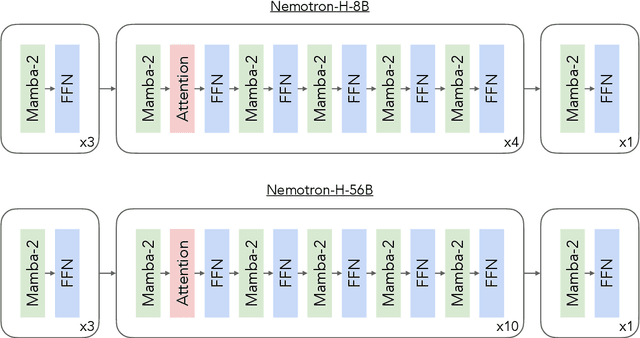
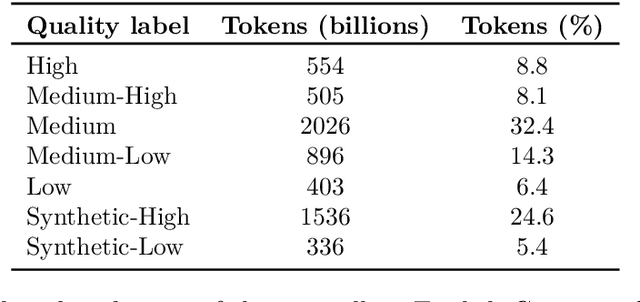
Abstract:As inference-time scaling becomes critical for enhanced reasoning capabilities, it is increasingly becoming important to build models that are efficient to infer. We introduce Nemotron-H, a family of 8B and 56B/47B hybrid Mamba-Transformer models designed to reduce inference cost for a given accuracy level. To achieve this goal, we replace the majority of self-attention layers in the common Transformer model architecture with Mamba layers that perform constant computation and require constant memory per generated token. We show that Nemotron-H models offer either better or on-par accuracy compared to other similarly-sized state-of-the-art open-sourced Transformer models (e.g., Qwen-2.5-7B/72B and Llama-3.1-8B/70B), while being up to 3$\times$ faster at inference. To further increase inference speed and reduce the memory required at inference time, we created Nemotron-H-47B-Base from the 56B model using a new compression via pruning and distillation technique called MiniPuzzle. Nemotron-H-47B-Base achieves similar accuracy to the 56B model, but is 20% faster to infer. In addition, we introduce an FP8-based training recipe and show that it can achieve on par results with BF16-based training. This recipe is used to train the 56B model. All Nemotron-H models will be released, with support in Hugging Face, NeMo, and Megatron-LM.
MIND: Math Informed syNthetic Dialogues for Pretraining LLMs
Oct 15, 2024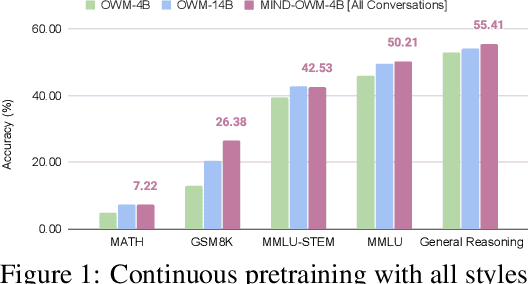

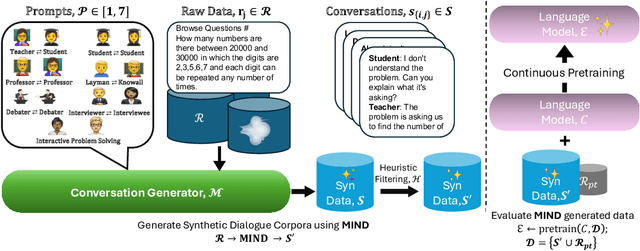

Abstract:The utility of synthetic data to enhance pretraining data quality and hence to improve downstream task accuracy has been widely explored in recent large language models (LLMs). Yet, these approaches fall inadequate in complex, multi-hop and mathematical reasoning tasks as the synthetic data typically fails to add complementary knowledge to the existing raw corpus. In this work, we propose a novel large-scale and diverse Math Informed syNthetic Dialogue (MIND) generation method that improves the mathematical reasoning ability of LLMs. Specifically, using MIND, we generate synthetic conversations based on OpenWebMath (OWM), resulting in a new math corpus, MIND-OWM. Our experiments with different conversational settings reveal that incorporating knowledge gaps between dialog participants is essential for generating high-quality math data. We further identify an effective way to format and integrate synthetic and raw data during pretraining to maximize the gain in mathematical reasoning, emphasizing the need to restructure raw data rather than use it as-is. Compared to pretraining just on raw data, a model pretrained on MIND-OWM shows significant boost in mathematical reasoning (GSM8K: +13.42%, MATH: +2.30%), including superior performance in specialized knowledge (MMLU: +4.55%, MMLU-STEM: +4.28%) and general purpose reasoning tasks (GENERAL REASONING: +2.51%).
Self-Imagine: Effective Unimodal Reasoning with Multimodal Models using Self-Imagination
Jan 16, 2024
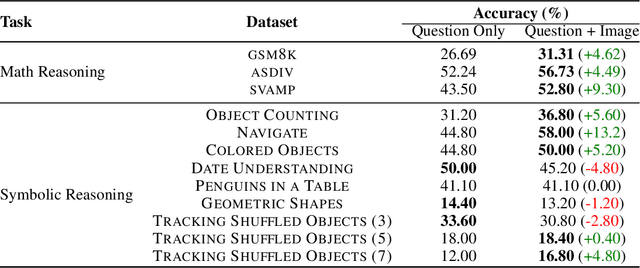


Abstract:The potential of Vision-Language Models (\textsc{vlm}s) often remains underutilized in handling complex text-based problems, particularly when these problems could benefit from visual representation. Resonating with humans' ability to solve complex text-based problems by (1) creating a visual diagram from the problem and (2) deducing what steps they need to take to solve it, we propose \textsc{Self-Imagine}. We leverage a single Vision-Language Model (\textsc{vlm}) to generate a structured representation of the question using HTML, then render the HTML as an image, and finally use the same \vlm to answer the question using both the question and the image. Our approach does not require any additional training data or training. We evaluate our approach in three mathematics tasks and nine general-purpose reasoning tasks using state-of-the-art \textsc{vlm}. Our approach boosts the performance of \textsc{vlm} on all math tasks (\gsm: +4.62\%; \asdiv: +4.49\%; \svamp: +9.30\%) and the majority of the general-purpose reasoning tasks by 0.4\% to 13.20\% while achieving comparable performance in other tasks. Code and data at https://github.com/snat1505027/self-imagine .
An In-depth Look at Gemini's Language Abilities
Dec 24, 2023Abstract:The recently released Google Gemini class of models are the first to comprehensively report results that rival the OpenAI GPT series across a wide variety of tasks. In this paper, we do an in-depth exploration of Gemini's language abilities, making two contributions. First, we provide a third-party, objective comparison of the abilities of the OpenAI GPT and Google Gemini models with reproducible code and fully transparent results. Second, we take a closer look at the results, identifying areas where one of the two model classes excels. We perform this analysis over 10 datasets testing a variety of language abilities, including reasoning, answering knowledge-based questions, solving math problems, translating between languages, generating code, and acting as instruction-following agents. From this analysis, we find that Gemini Pro achieves accuracy that is close but slightly inferior to the corresponding GPT 3.5 Turbo on all tasks that we benchmarked. We further provide explanations for some of this under-performance, including failures in mathematical reasoning with many digits, sensitivity to multiple-choice answer ordering, aggressive content filtering, and others. We also identify areas where Gemini demonstrates comparably high performance, including generation into non-English languages, and handling longer and more complex reasoning chains. Code and data for reproduction can be found at https://github.com/neulab/gemini-benchmark
Difference-Masking: Choosing What to Mask in Continued Pretraining
May 23, 2023
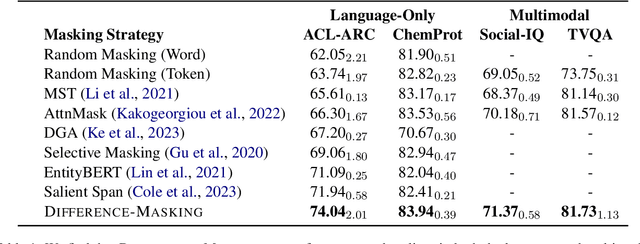
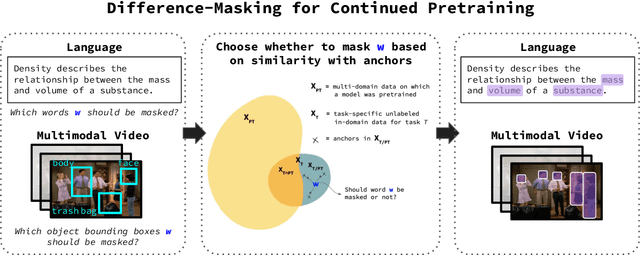
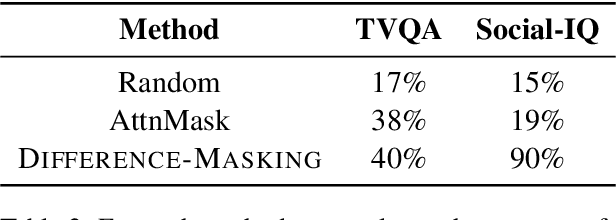
Abstract:Self-supervised learning (SSL) and the objective of masking-and-predicting in particular have led to promising SSL performance on a variety of downstream tasks. However, while most approaches randomly mask tokens, there is strong intuition from the field of education that deciding what to mask can substantially improve learning outcomes. We introduce Difference-Masking, an approach that automatically chooses what to mask during continued pretraining by considering what makes an unlabelled target domain different from the pretraining domain. Empirically, we find that Difference-Masking outperforms baselines on continued pretraining settings across four diverse language and multimodal video tasks. The cross-task applicability of Difference-Masking supports the effectiveness of our framework for SSL pretraining in language, vision, and other domains.
 Add to Chrome
Add to Chrome Add to Firefox
Add to Firefox Add to Edge
Add to Edge